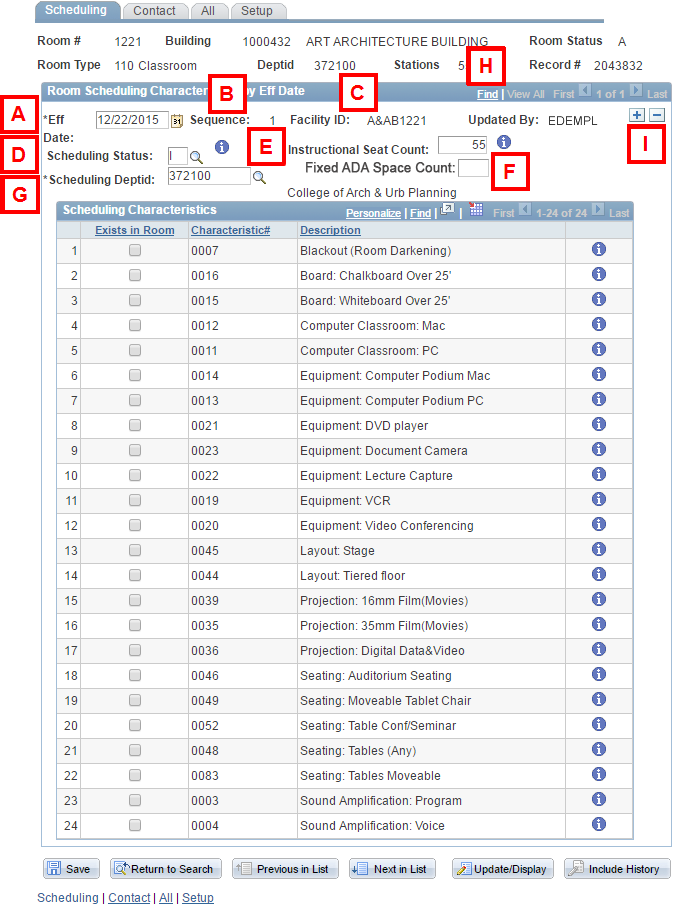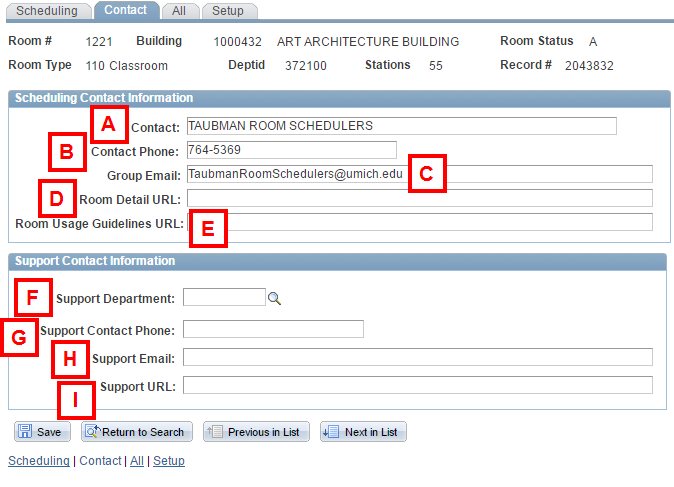Overview
This document provides general information on maintaining room characteristics in M-Pathways. Refer to Updating Room Characteristics for specific instructions on maintaining room characteristics in M-Pathways. You can also complete the Updating Room Characteristics – Guided Simulation for a walkthrough of some of the concepts described in this document.
The Room Characteristics component of M-Pathways contains four pages:
- Scheduling – (Required) Use this page to track scheduling characteristics. These are characteristics that would match a room to a particular instructional need (e.g., some film classes must be held in rooms with 35mm film projectors, so 35mm projectors are a scheduling characteristic).
- Contact – (Required) Use this page to record the contact information for the department that is responsible for scheduling and supporting this room. You can also list any URLs that provide more detail or usage guidelines for the room.
- All – (Optional) Use this page to track both scheduling characteristics, and any non-scheduling characteristics in the room. A non-scheduling characteristic is one for which there is no particular instructional need (e.g., no class in your department requires a certain flooring type, yet you want to track which rooms contain which type). Tracking non-scheduling characteristics is optional, but can be done if it is useful to your department.
- Setup – You do not need to enter any data on this page (the fields are not editable). It contains additional facility information used by the Registrar’s Office.
Navigation
NavBar > Navigator > Space Management > Rooms > Room Characteristics
Process Overview
Room characteristics are maintained for two purposes.
- (Required) Scheduling characteristics for classrooms (room type 110) are recorded in order to support departmental scheduling and the Registrar’s Office Shared Scheduling process.
- (Optional) Scheduling or non-scheduling characteristics can be recorded for any room type to meet the possible needs of your unit.
As the Room Characteristics Maintainer, you are expected to update information for a classroom when:
- Your unit adds a new classroom in M-Pathways.
- Scheduling characteristics change for a classroom. Changes must be updated in the system as soon as they occur, to ensure that M-Pathways reflects the most up-to-date information. Accurate data enables departments and the Registrar’s Office to appropriately match instructional needs with available classrooms.
- You know that room characteristics changes will occur in the future (i.e., you want to add an effective-dated set of characteristics that will become effective at a future date). For example, suppose your unit ordered video conferencing equipment for a classroom, and it will be installed next month. You can add a record that is dated one month from now.
It is strongly suggested that you add a reminder to your calendar to at least update room characteristics in M-Pathways as follows:
- In early December for Spring, Spring/Summer, Summer, and Fall terms.
- In early August for Winter term.
Scheduling and All Pages
Field Descriptions

| Letter | Field/Button | Description |
|---|---|---|
| A | Eff Date | The date on which the set of room characteristics becomes effective. |
| B | Sequence | The effective sequence number for the effective-dated record. This system-assigned number will be 1unless there are multiple records for one effective date (the second record for the date will be 2, etc.). The record with the greatest sequence number is the most accurate record for that date. |
| C | Facility ID | A code representing a unique identifier for a facility, e.g. CHEM1800. |
| D | Scheduling Status |
A code specifying whether the room is Active or Inactive for scheduling purposes. Valid values are:
Note: If you have a room that did not previously have any characteristics assigned to it, the system will default to I. To use the system for class/event scheduling in this room, change the value to A. |
| E | Instructional Seat Count | The number of stations with a corresponding writing or lab surface assigned to students for instruction. In computer labs, this includes only seats with assigned computers. The number does not include instructor stations or other seating types without writing surfaces. |
| F | Scheduling Deptid | The Department ID of the department with scheduling authority for this facility. |
| G | Stations | The total number of seats, excluding instructor stations. |
| H | Add row Delete row |
Add or delete an effective dated row. |
Note: If you are entering room characteristics for a room that did not previously have any characteristics associated with it, you will see system-defaulted values in the Scheduling Deptid, Instructional Seat Count, and Scheduling Status fields.
Effective-Dating
Room Characteristics information for a room is contained in effective-dated records. Effective-dating enables you to see historical, current, and future sets of room characteristics. Take note of the following important information regarding effective-dating:
- When you first navigate to a room in the Room Characteristics component, the greatest effective-dated record (this could be a future date) is displayed on the Scheduling page. To see any other effective-dated rows, click Previous Record or Next Record. To see all records for this room at once, click View All.
- When you add a record to a room, verify the effective date that defaults and overwrite it if necessary.
- Effective-dated records apply to both the Scheduling and the All pages (i.e., if you add a record, it is added for both pages).
- When you click Add Row from within an effective-dated record, the set of characteristics are copied from the existing record to the new one. Therefore, you should add the new effective-dated set of characteristics from within the record that is sequentially prior to the effective date you are adding.
- Because the characteristics in each effective-dated record are treated as a set, changes to individual characteristics do not automatically carry forward to future effective-dated records. Whenever you add a record, determine whether or not the individual change(s) applies to any future-dated records that are already in the system. If a characteristic(s) will still be applicable, you must update each future-dated record with the change(s).
- You can edit a future-dated record that you created, but you cannot edit a future-dated record created by someone else. If the information in someone else’s record needs updating, you must add a new record with the same effective date (then make any changes and save the record).
Updating Contact Information - Field Descriptions
Note: Enter as much information as possible in the fields provided.

| Letter | Field/Button | Description |
|---|---|---|
| A | Contact | The name of the department or person who is responsible for scheduling the room. |
| B | Contact Phone | The phone number for an individual or group that is responsible for scheduling the room. |
| C | Group Email |
The address to which questions about this room should be directed. Notes:
|
| D | Room Detail URL | The web address of a page, if available, that provides additional details about a room (for example, square footage). The address must include the http://or https://prefix. |
| E | Room Usage Guidelines URL | The web address of a page, if available, that provides guidelines for using the room. The address must include the http://or https://prefix. |
| F | Support Department | The department that supplies support for the room (e.g., for audio-visual equipment assistance). |
| G | Support Contact Phone | The phone number for an individual or group that is responsible for supporting the room. |
| H | Support Email | The e-mail address to which questions about room support should be directed. Note: It is strongly preferred that you enter a group e-mail address rather than a personal e-mail address. This reduces or eliminates the need to maintain this information during times of employee transitions. |
| I | Support URL | The web address of a page, if available, that provides guidelines or information on room support. The address must include the http://or https://prefix. |
Additional Information
- If you have any questions about access, security, or who should have the role of Room Characteristics Maintainer for your unit, please contact your Financials Unit Liaison.
- If you do not see the Room Characteristic you need, or you have any questions about a characteristic, send an e-mail message to classroom.char.group@umich.edu.
- Refer to: http://www.provost.umich.edu/space for more information about the Shared Scheduling process.
- If you have questions about using M-Pathways, please contact the ITS Service Center at 734-764-HELP (764-4357), or file a web request.
- Visit the Office of the Registrar’s scheduling and curriculum information website.